

 |
September 13, 2017: Montmorency Falls and St. Anne de Beaupre Church |
 |
Return to the Index for Our Trip to Quebec City |
Today we will be leaving Montreal to head over to Quebec City- traveling by train. When we arrive there, we will be checking into our hotel and then going out for an evening walk and some dinner.
The Train to Quebec City
When we were all packed and checked out of the Hotel William Gray, we took two taxis over to Montreal's Central Train Station- the major commuter rail hub of the the province of Quebec. We were seven of the some 11 million people that pass through this station each year.
|
The station building and associated properties are actually owned not by the City of Montreal, but by a real estate investment trust. Prior to 2007, the station had been owned by Canadian National Railway (CN).
Central Station is at the center of the Quebec City–Windsor Corridor, the busiest inter-city rail service area in the nation (marketed as the Corridor), which extends from Windsor and Sarnia in the west, through Toronto, Ottawa, and Montreal, to Quebec City in the east. Inter-city trains at Central Station are operated by Via Rail and Amtrak, while commuter rail services are operated by Réseau de transport métropolitain (RTM). The station is also connected to the Montreal Metro subway system. Central Station is the second-busiest Via Rail station in Canada, after Toronto Union Station.
I tried my hand at creating a panoramic view of the main concourse, but I was only moderately successful. Here is the best of the pictures that I was able to take:

Right after we'd entered the station and checked our bags for the train, I had everyone gather for a group picture. We hung out for about twenty minutes, keeping an eye on the annunciator board. Ours was the second train from the top, and would board at 12:25 for a 12:45 departure. Presently, the train was opened for boarding, and we queued up to have our tickets checked and head down the stairs to the platform to board our train. We had reserved seats, so it didn't matter that we hung back to take a few pictures.
|
 (Click on Thumbnails to View) |
Fred was the one who chronicled our journey by taking pictures of the passing scenery, beginning as we slowly pulled out of Montreal, crossed the St. Lawrence a couple of times, and headed through the lush farmland between Montreal and Quebec City. He took quite a few pictures, and I have tried to select a representative sample of them. I think you'll agree that the countryside was really pretty:
 (Click on Thumbnails to View) |
We arrived at Quebec City's Gare du Palais ("Palace Station") in the late afternoon. The station is Quebec City's main train and bus terminal, and its name comes from its proximity to the Palace of the Intendant of New France. Built in 1915 by the Canadian Pacific Railway, the two-storey châteauesque station is similar in design to the Château Frontenac. The station had no passenger rail service from 1976 to 1985, although it once again hosts regular daily services west to Montreal's Central Station. It was designated a Heritage Railway Station in 1992.
|
The Palais Station continued to serve as an important rail link, undergoing a complete renovation in 1985. By then, service to the areas further east was provided on rail lines north of the St Charles River, and the Gare du Palais became a rail terminus for the service to Montreal. When our train came to a stop, we all got off and met on the murkily-lit platform and then headed off to claim our luggage. As we walked down towards the entrance, I stopped to take a picture of our train in the station.
When we all got outside, Guy, Fred, and I thought that since our hotel was not all that far away we would just walk (although if we didn't have luggage on rollers, we probably would not have). I thought I knew the shortest way (marked on the map at left), but I confess I made a wrong turn near the station and we ended up going quite a bit out of our way, although we ended up right at the hotel to meet everyone else.
The Hotel Manoir d'Auteuil
Nancy had picked Le Manoir d’Auteuil for our stay in Quebec City, and she extended her generosity to Guy, Fred, and I yet again in treating us to our stay in this lovely hotel. As we have done so often in the past, we thank her profusely. The Manoir d'Auteuil turned out be a glamourous (Edith Piaf had actually stayed in the room that we ended up occupying) and elegant French art deco boutique hotel situated in an historic building. The staff was attentive (and multi-lingual), and every room was different. The hotel was located on the eponymous Rue d'Auteuil, just inside the old city walls, across from the Parliament building and near the Chateau Frontenac.
|
The story began in 1775 when Jonathan Sewell II (1729–1796), the last of the Crown’s Attorney Generals of Massachusetts, fled the American Revolution after his wife thwarted an attack by 50 American patriots by giving away the contents of his wine cellar. His son, Jonathan Sewell Jr. studied law and moved to Quebec in 1786. He became an important and influential citizen— a lawyer, judge, musician, politician and author. He served as the Chief Justice of Lower Canada from 1808 to 1838. Sheriff William Smith Sewell was one of the 13 children he raised within the St. Louis Gate of Quebec City.
In 1835 Sheriff William Smith Sewell (1798–1866) commissioned the architect Frederick Hacker to design a four-story stone house in “the London style” for his family. He hired the stonemason Pierre Bélanger to build stone walls and the arched stone entrance that exists to this day. The cost of construction was 565 English pounds. A fire in 1853 destroyed most of the house leaving only the stone walls and the archway. The Sheriff rebuilt his home and kept it in his family until 1871.
Businessman George-Élie Amyot, president of the Banque Nationale, bought the building in 1912, and did some remodeling of the portico. A year later, he gave the house to his daughter Alice Paquet and her husband (who was the Chief Surgeon at not one, but two local hospitals).
|
The house was converted into a hotel in 1953, and guests were able to experience the luxurious and stylish accommodations that continue to distinguish Le Manoir d’Auteuil. The famous French singer Edith Piaf was among the early fans of Le Manoir d’Auteuil’s opulent French art deco style. She chose to stay in the beautiful suite with a blue tiled bathroom whenever she visited Quebec City. As it turned out, this was the room that Fred and I occupied, but more on that in a minute.
The art deco style woodwork and ornate bathrooms that garnered the admiration of Dr. Paquet’s visitors was indeed pretty neat, and I understand that many people stay here specifically for those design touches. But we also received warm and personal attention at the Manoir d'Auteuil, which was actually as much a bed and breakfast as it was a hotel. We all took a number of pictures here during our stay, and I am going to aggregate all of them into this section.
Room Number One
|

(Click on Thumbnails to View) |
|
After thinking about the room for a bit, and wandering around it, we began to see the drawbacks to staying in it. Although the stairs weren't a problem for us, they were just a nuisance. Secondly, I've always felt odd when there is no way to close off a bathroom. Third, the bathroom was oddly-designed, and there were a number of difficulties even just with places to set things down.
But when I started to think about it, the worst aspect was going to be the windows. There was a window high up above the bed, with no way to reach it and certainly no way to close it to darken the room. The bathroom also had a large window, and since the bathroom was in a loft, there was no way to keep that light from coming in, either. I am one of those people who sleeps best in a dark room, so this one was going to be a problem.
Guy, Karl and Nancy, and Ron and Prudence had already settled in their rooms, so I just went downstairs to reception to see if there was another room we could switch to. There was and we did.
Room Number Two
|
In boutique hotels like this one, you often find that someone famous has occupied your room, as these kinds of hotels are favored by the rich and famous as they are much smaller, much quieter, and of course not nearly so busy.
So who'd stayed in our room before? Those of you of a certain age may remember Edith Piaf- this room was her room of choice when she came to Quebec City and stayed, as she always did, here at the Manoir d'Auteuil!
We were not surprised that the room was nicely-appointed and very comfortable; this being a boutique hotel we were pretty certain it would be. But we were totally unprepared for the bathroom- which turned out to be almost as large as the room itself.
|
Not a small, cozy bathroom by any means, but I could definitely picture a movie star or singer lounging around in it.
Here are a couple more pictures we took of this incredible space:
 (Click on Thumbnails to View) |
Public Spaces
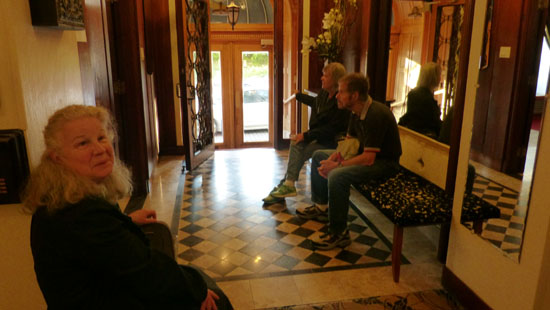 |
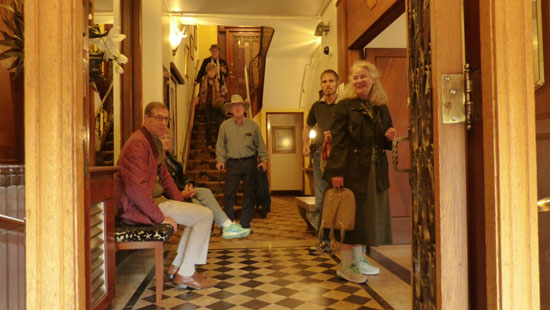 |
Outside
|
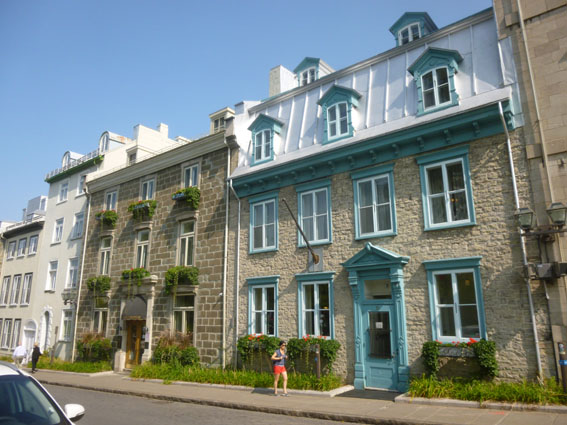

The Plains of Abraham
By the time we had all gotten checked in, and our room-juggling was done, we gathered together in the lobby and then went out for a walk around the neighborhood. I suggested walking over to the old city walls, through the walls, and then to the Plains of Abraham- adjacent to the Citadel on the banks of the St. Lawrence River.
|
On the other side of the Rue d'Auteuil, across from the hotel, is a large park that contains a segment of the old city walls; you can see them in the aerial view at left, and a bit later on in our visit Fred and I will go atop them to see what we can see. But we crossed to that side of the street and headed up the sidewalk towards the Grande Allee. There, we turned southwest on Grande Allee and came to the Porte St. Louis
We walked up the Grande Allee towards the old gate, and just before we got there, found a small statue beside the sidewalk, so Prudence took a picture of Ron and Winston Churchill.
|
The first street that the walls cross is the Grande Allee, and wherever the walls did cross a thorofare, a gate had to be constructed. The Porte St. Louis dates back to at least 1694 when it was first constructed. That gate was demolished in 1791 because of its poor condition; it was rebuilt immediately thereafter. This gate lasted until 1823 when it was replaced. It was eventually removed altogether in 1871 before being replaced in 1880 by Lord Dufferin with the gate we see now.
We were on the north side of the street as we approached the gate, and I saw a way that I could get up onto the gate itself, so I did that while Guy continued walking below me. When I got to the top of the gate, I found that I could not cross over it as the top of the gate was blocked off. So I went back down the way I had come and followed everyone to the other side of the street.
|
|
The monument was inaugurated with the Royal 22nd Regiment, the crew of the HMS Valerian and more than 200 veterans in attendance. With many other dignitaries present, the cross was unveiled by Canada’s Governor General, Julian Byng, Baron of Vimy. A two-minute silence was observed and flowers were placed at the foot of the monument. A ceremony was held in the fall of 1947 to include in the tribute those who fell in World War II. On November 9, a token quantity of French soil was buried under the knoll on which the cross stands, on the side facing the Grande Allée. Finally, the sacrifice of those who fell in the Korean War (1950-1953) was also commemorated. Every year, at 11 a.m. on Remembrance Day, November 11, the anniversary of the Armistice, a ceremony takes place around the cross, attended by war amputees, veterans, dignitaries and soldiers paying tribute to the soldiers who sacrificed their lives.
|
The light was fading this afternoon, but we pushed on to the river anyway- since it was a bit early to try to go out for dinner. I thought we would probably return here later in our stay, but for now it was a pleasant walk.
|
When we got to the overlook, Guy took pictures of most of the rest of us:
 (Click on Thumbnails to View) |
The light was fading this afternoon, and I thought that the view of the St. Lawrence would be much, much better during the daytime, so we thought that since this was so close to the hotel that we would try to come back again. We eventually did, so I will have more to say about the Plains of Abraham later on.
|
 (Click on Thumbnails to View) |
We stayed on the promenade for a little while and then walked back to the Manoir d'Auteuil to relax before dinner.
Evening Walk and Dinner
We relaxed in the hotel for a while, and all met in the bar area for a glass of wine before heading out to dinner at a local restaurant that someone had gotten a recommendation for from the young ladies at the front desk.
|
Fred and I took our cameras along and, since we did, each of took a picture in the restaurant, whose cuisine I would have called "country French"- very basic food but quite good. Fred took a picture of all of us (except for himself, of course), and I took a picture of Guy, Ron, and Prudence perusing the menu and wine list. We all had different things, I think, but it was a good.
When we were done with dinner and were back outside for our walk home, I took this picture of another cafe across the street. Then we all headed off for the hotel, although when we got back to the esplanade, Fred, Guy and I took rather the long way around so we could have a closer look at two more of the gates through the old city walls.
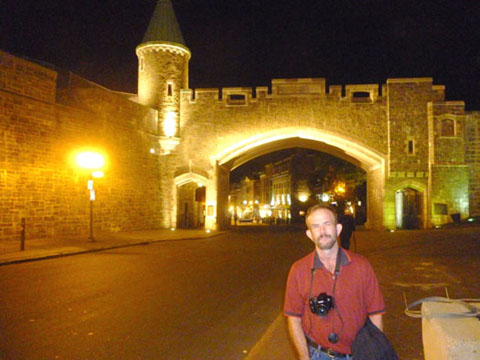 Porte St. Jean dates back to at least 1694. It was demolished and rebuilt in 1791 and 1865. The present gate was built in 1939. |
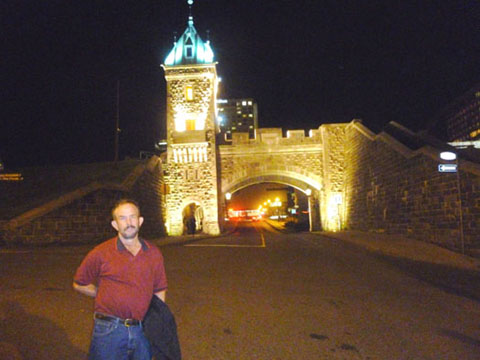 Porte Kent was erected in 1879 and named after Queen Victoria's father The Duke of Kent. |
Well, we've had a long day, and I need to be up early tomorrow to take a taxi out to the Enterprise Rent-a-Car office. I have engaged a 7-passenger Ford Explorer for our next two days here. Tomorrow we will be visiting Montmorency Falls and the Shrine of Sainte-Anne-de-Beaupré. I also hope to take the group to Canyon Sainte-Anne.
You can use the links below to continue to another photo album page.
 |
September 13, 2017: Montmorency Falls and St. Anne de Beaupre Church |
 |
Return to the Index for Our Trip to Quebec City |